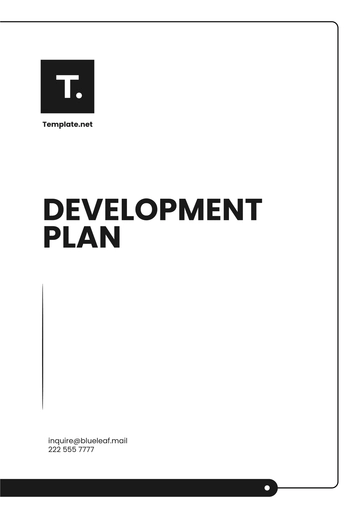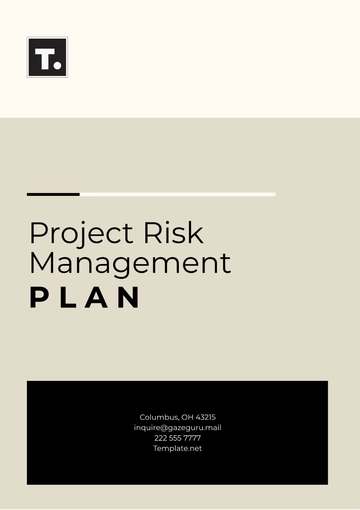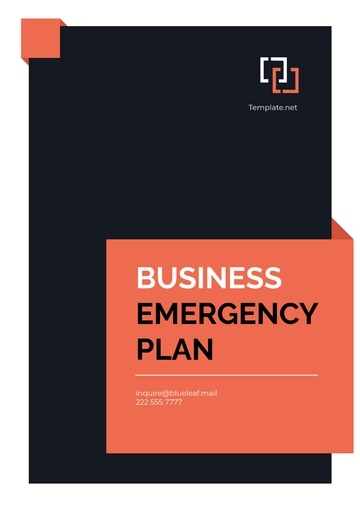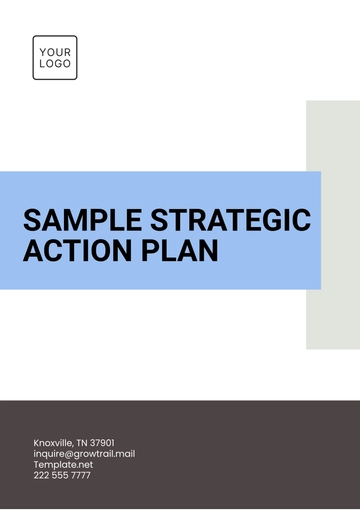Free Crisis Communication Management Plan
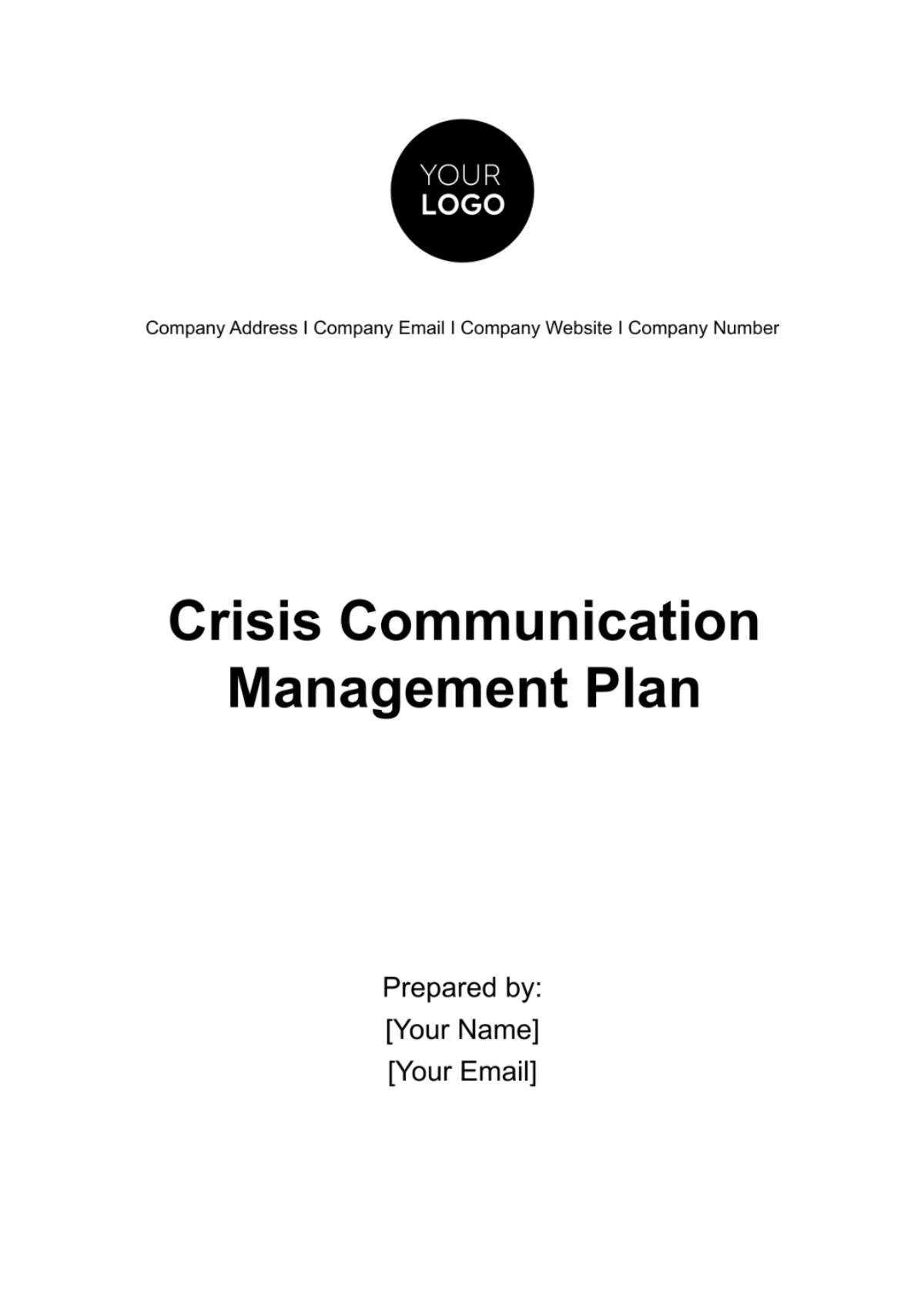
A. Introduction
This plan serves as our blueprint, combining legal compliance with proactive strategies to safeguard our reputation and maintain trust. It empowers us to deliver accurate and timely information to stakeholders, ensuring their safety and confidence. As we navigate crises, this document will be our compass, guiding us toward effective communication and resolution.
B. Crisis Team and Contacts
In times of crisis, a well-prepared and swiftly responsive team is essential. This section outlines key individuals and contacts who play pivotal roles in our emergency response efforts. Below, you'll find a table detailing the Crisis Team and their contact information.
Role | Name | Phone Number | |
Crisis Coordinator | [Name] | [Email] | [Number] |
Safety Officer | |||
Medical Officer | |||
Communication Lead |
C. Crisis Communication Objectives
In the face of a crisis, effective communication is greatly important. This section outlines our key communication objectives, ensuring transparency, trust, and timely information dissemination. Below, you'll find three crucial Crisis
Communication Objectives:
Timely Information: Provide real-time updates to keep stakeholders informed and reduce uncertainty.
Maintain Trust: Uphold trust through open, honest, and consistent messaging, reinforcing our commitment to safety.
Manage Reputation: Safeguard our reputation by addressing concerns proactively and demonstrating responsible crisis management.
D. Risk Assessment and Scenarios
In this section, we delve into the core of preparedness - risk assessment and scenarios. Identifying potential risks and understanding scenarios allows us to proactively plan for emergencies. Below, you'll find five examples of Risk Assessment and Scenarios:
Scenario | Risk Assessment | Response Strategy |
Severe Weather | Assess the impact of severe storms, hurricanes, or tornadoes on our facilities. | Formulate response strategies, designate safe zones, and establish communication protocols. |
Fire Hazards | Analyze fire risks, including electrical faults or chemical storage. | Develop evacuation plans, ensure fire suppression measures, and conduct regular fire drills. |
Pandemic Response | Prepare for pandemics like influenza outbreaks. | Outline health protocols, establish remote work procedures, and maintain a supply of essential medical resources. |
Active Shooter | Address the potential threat of an active shooter. | Emphasize employee safety, develop active shooter response plans, and conduct security training. |
Natural Disasters | Plan for earthquakes or floods. | Identify safe zones, establish evacuation routes, and ensure access to emergency supplies and first aid. |
E. Communication Protocols
At [Your Company Name], we understand that effective communication is the foundation of a successful crisis response. In this section, we lay out our communication protocols, which serve as a blueprint for ensuring clear, timely, and precise information sharing during emergencies.
Key Components of Our Communication Protocols
Chain of Command: Clearly define roles and responsibilities within our communication hierarchy to authorize and convey information without confusion.
Notification System: Establish a dependable notification system that integrates various tools like email, text messaging, and phone calls to reach all stakeholders promptly.
Message Templates: Develop pre-approved message templates for different scenarios to maintain consistency and accuracy in our communication.
Media Relations: Designate a media liaison responsible for interacting with the press, ensuring external communications align with our crisis messaging.
Frequency of Updates: Determine how often we'll provide updates based on the evolving situation, ensuring regular contact with internal and external stakeholders.
Escalation Procedures: Outline procedures for escalating communication to higher levels of authority as the crisis unfolds.
Privacy and Sensitivity: Address the privacy and sensitivity of information, ensuring we adhere to legal and ethical standards.
Testing and Training: We regularly test our communication systems and conduct training exercises to familiarize all team members with these protocols.
F. Stakeholder Analysis
Understanding and engaging with our stakeholders is important in crisis management. In this section, we conduct a comprehensive stakeholder analysis, identifying the individuals, groups, and organizations that may be impacted by or have an influence on our emergency response efforts.
Element | Description |
Identification | Identify relevant stakeholders: employees, customers, suppliers, local communities, regulatory bodies, media outlets, and more. |
Prioritization | Prioritize stakeholders based on their influence and interest in our organization during a crisis. |
Engagement Strategy | Develop tailored engagement strategies for each stakeholder group, aligning communication and actions with their needs and expectations. |
Communication Channels | Determine effective communication channels: email updates, social media, press releases, direct meetings, etc. |
Feedback Mechanisms | Establish mechanisms for stakeholders to provide feedback and express concerns, enabling prompt responses. |
Information Dissemination | Outline how and when information will be shared with stakeholders to ensure transparency and maintain trust. |
Mitigating Risks | Identify potential risks related to stakeholder engagement and develop strategies to mitigate them. |
Continuous Monitoring | Continuously monitor stakeholders' evolving needs and perceptions, adapting our approach as necessary. |
G. Media Relations
Media plays a crucial role in shaping public perception during a crisis. In this section, we outline our media relations strategy, which is essential for ensuring accurate, responsible, and transparent communication with the press and the public.
Key Components of Our Media Relations Strategy:
Designated Spokesperson: We appoint a trained and authorized spokesperson to represent our organization in all media interactions, ensuring consistent and accurate communication.
Media Contact List: Maintaining an up-to-date list of media contacts, including local and national outlets, to facilitate rapid communication during a crisis.
Message Consistency: Ensuring that our messaging aligns with our overall crisis communication strategy, maintaining transparency and consistency in our communications with the media.
Response Time: Committing to providing timely responses to media inquiries to keep the public informed while managing the narrative effectively.
H. Message Development
In the midst of a crisis, crafting clear, accurate, and empathetic messages is paramount. In this section, we delve into our message development process, ensuring that our communication resonates with stakeholders, maintains transparency, and upholds our commitment to responsible crisis management.
Key Aspects of Our Message Development Process:
Audience Understanding: Our message development process begins with a deep understanding of our various stakeholder groups. We conduct thorough analysis to identify their unique needs, concerns, and expectations.
Message Consistency: Maintaining consistency in our messaging is of great import. We adhere to a unified message framework across all communication channels. This consistency ensures that information is clear, coherent, and aligned with our overarching crisis communication strategy.
Empathy and Compassion: We believe in infusing empathy and compassion into our messages. Acknowledging the emotional impact of a crisis on individuals and communities, our messages reflect genuine concern and understanding.
Accuracy and Transparency: Accuracy and transparency are non-negotiable principles in our message development process. We prioritize providing reliable information to stakeholders. In times of crisis, trust is fragile, and any misinformation can have severe consequences.
Response Speed: We recognize the importance of timely communication. Our commitment to swift response times is a cornerstone of our message development process. We address inquiries and alleviate concerns in real-time, demonstrating our responsiveness and dedication to stakeholder needs.
I. Monitoring and Evaluation
In this section, we explore our approach to monitoring and evaluating our crisis response efforts. By systematically assessing our actions and outcomes, we ensure that we learn from each crisis, refine our strategies, and enhance our ability to protect our stakeholders.
Key Components of Our Monitoring and Evaluation Process:
Performance Metrics: We establish clear performance metrics to measure the effectiveness of our crisis response. These metrics cover factors such as response time, message reach, stakeholder satisfaction, and impact assessment.
Data Collection: We collect data throughout the crisis response, including real-time feedback, incident reports, and media monitoring. This data serves as the foundation for our evaluation.
Post-Incident Reviews: After each crisis, we conduct comprehensive post-incident reviews. These reviews involve a multidisciplinary team that assesses what went well, areas for improvement, and lessons learned.
Continuous Improvement: We emphasize a culture of continuous improvement. Insights from evaluations are integrated into our crisis management strategy, enabling us to adapt and enhance our preparedness for future crises.
Our monitoring and evaluation process not only holds us accountable but also ensures that we evolve and strengthen our crisis management capabilities. It reaffirms our commitment to safeguarding the well-being of our stakeholders and maintaining the highest standards of safety and responsibility.
J. Recovery and After-Action Review
Our commitment to stakeholder well-being continues with a dedicated focus on recovery and a thorough after-action review. This stage is pivotal as it allows us to assess the impact of the crisis, ensure a smooth return to normal operations, and draw essential lessons for the future.
Recovery Efforts: Our recovery efforts are geared towards restoring normalcy as swiftly and seamlessly as possible. We prioritize the physical and emotional well-being of our stakeholders, offering necessary support, and ensuring access to any required resources. This includes facilitating repairs and cleanup, providing medical assistance, and addressing any lingering concerns. Our aim is to guide all those affected through the recovery process with compassion and efficiency.
After-Action Review: Following the crisis, we conduct a comprehensive after-action review. This involves a meticulous assessment of our response, highlighting what worked effectively and identifying areas for improvement. We gather input from our crisis response team, stakeholders, and external experts if necessary. The insights gained from this review are invaluable, as they inform our future crisis management strategies, reinforcing our commitment to continuous enhancement and ensuring that we are better prepared for any future challenges.
Our dedication to recovery and the after-action review demonstrates our unwavering commitment to the safety, well-being, and resilience of our stakeholders. It is through these efforts that we not only recover from the immediate impact of a crisis but also emerge stronger and better prepared for whatever the future may hold.
- 100% Customizable, free editor
- Access 1 Million+ Templates, photo’s & graphics
- Download or share as a template
- Click and replace photos, graphics, text, backgrounds
- Resize, crop, AI write & more
- Access advanced editor
Craft a robust crisis communication strategy effortlessly with Template.net's Crisis Communication Management Plan Template. This editable and customizable template, enhanced with our Ai Editor Tool, streamlines the process of creating comprehensive crisis plans tailored to your organization's needs. Safeguard your reputation and navigate crises effectively with Template.net's innovative solutions.
You may also like
- Finance Plan
- Construction Plan
- Sales Plan
- Development Plan
- Career Plan
- Budget Plan
- HR Plan
- Education Plan
- Transition Plan
- Work Plan
- Training Plan
- Communication Plan
- Operation Plan
- Health And Safety Plan
- Strategy Plan
- Professional Development Plan
- Advertising Plan
- Risk Management Plan
- Restaurant Plan
- School Plan
- Nursing Home Patient Care Plan
- Nursing Care Plan
- Plan Event
- Startup Plan
- Social Media Plan
- Staffing Plan
- Annual Plan
- Content Plan
- Payment Plan
- Implementation Plan
- Hotel Plan
- Workout Plan
- Accounting Plan
- Campaign Plan
- Essay Plan
- 30 60 90 Day Plan
- Research Plan
- Recruitment Plan
- 90 Day Plan
- Quarterly Plan
- Emergency Plan
- 5 Year Plan
- Gym Plan
- Personal Plan
- IT and Software Plan
- Treatment Plan
- Real Estate Plan
- Law Firm Plan
- Healthcare Plan
- Improvement Plan
- Media Plan
- 5 Year Business Plan
- Learning Plan
- Marketing Campaign Plan
- Travel Agency Plan
- Cleaning Services Plan
- Interior Design Plan
- Performance Plan
- PR Plan
- Birth Plan
- Life Plan
- SEO Plan
- Disaster Recovery Plan
- Continuity Plan
- Launch Plan
- Legal Plan
- Behavior Plan
- Performance Improvement Plan
- Salon Plan
- Security Plan
- Security Management Plan
- Employee Development Plan
- Quality Plan
- Service Improvement Plan
- Growth Plan
- Incident Response Plan
- Basketball Plan
- Emergency Action Plan
- Product Launch Plan
- Spa Plan
- Employee Training Plan
- Data Analysis Plan
- Employee Action Plan
- Territory Plan
- Audit Plan
- Classroom Plan
- Activity Plan
- Parenting Plan
- Care Plan
- Project Execution Plan
- Exercise Plan
- Internship Plan
- Software Development Plan
- Continuous Improvement Plan
- Leave Plan
- 90 Day Sales Plan
- Advertising Agency Plan
- Employee Transition Plan
- Smart Action Plan
- Workplace Safety Plan
- Behavior Change Plan
- Contingency Plan
- Continuity of Operations Plan
- Health Plan
- Quality Control Plan
- Self Plan
- Sports Development Plan
- Change Management Plan
- Ecommerce Plan
- Personal Financial Plan
- Process Improvement Plan
- 30-60-90 Day Sales Plan
- Crisis Management Plan
- Engagement Plan
- Execution Plan
- Pandemic Plan
- Quality Assurance Plan
- Service Continuity Plan
- Agile Project Plan
- Fundraising Plan
- Job Transition Plan
- Asset Maintenance Plan
- Maintenance Plan
- Software Test Plan
- Staff Training and Development Plan
- 3 Year Plan
- Brand Activation Plan
- Release Plan
- Resource Plan
- Risk Mitigation Plan
- Teacher Plan
- 30 60 90 Day Plan for New Manager
- Food Safety Plan
- Food Truck Plan
- Hiring Plan
- Quality Management Plan
- Wellness Plan
- Behavior Intervention Plan
- Bonus Plan
- Investment Plan
- Maternity Leave Plan
- Pandemic Response Plan
- Succession Planning
- Coaching Plan
- Configuration Management Plan
- Remote Work Plan
- Self Care Plan
- Teaching Plan
- 100-Day Plan
- HACCP Plan
- Student Plan
- Sustainability Plan
- 30 60 90 Day Plan for Interview
- Access Plan
- Site Specific Safety Plan










